As each year we are not releasing any "solutions" until the season ends. As mentors, there are some directions we could give. As a team, you could learn from our tutorials and building instructions and develop your own solutions to the missions. When you do, send us some pictures and videos :)
A very good description of the missions could be found at the first lego league site
Approach
What we could do as mentors, is to help with directions and questions based on experience and tutorials from previous years. We plan to update the page a few more times during the season, so check for updates from time to time.
Prerequisites
Move through the FIRST LEGO League Robot Game Preparation. The complete guide before proceeding to the resources below. This will give you a much deeper and better understanding of the references that we are making

With a subscription for all the team members, students could move together through the courses, building instructions and programs while the mentor tracks the programs and navigates them.
Missions Inspiration and Directions
Tip:
Go and place the payload carts. You need to precisely place them on the rail. To achieve that use the white panel in the back of the rail to align your attachment. There is no need to use a motor to drop the carts in place. You can just have a sliding mechanism.
Categories:
Look for inspiration:

Dropping a LEGO human carrier. FIRST LEGO League Trash Trek 2015
Look for ways of dropping objects

Precisely dropping the chicken. FIRST LEGO League Trash Trek 2015
Again look for ways of dropping objects
Tip:
This mission involves just one simple push or pull. You can do both with one robot movement. The only issue is that the Solar Panel Array is at distance so you will need a longer passive attachment to reach it. It's one loop, so probably the simplest attachment will do the job. However, the loop should be lifted during collection, so it's best to go with the rubber band attachments
Categories:
Look for inspiration:

Box Robot Two. Push/Pull attachment with a Rack on the right side
The rack attachment could help with either pushing or pulling. Think of using axles.
Tip:
Same as mission 1. The main difference is that the core sample has no loop so the attachment must be a little different. The second part of the mission is to take the ejected brick and bring it to the planet area. The tricky part is to take the brick and move it without losing it. This can be achieved either with special attachment or with slow and precise movement of the robot.
Categories:
Look for inspiration:

Dropping a LEGO human carrier. FIRST LEGO League Trash Trek 2015
The mission involves dropping objects.

Precisely dropping the chicken. FIRST LEGO League Trash Trek 2015
This mission also involves dropping objects

Pinless attachment added below the robot
Place a small attachment below the robot and the brick could fall

Quick Pinless EV3 Attachment
Another way to collect the brick
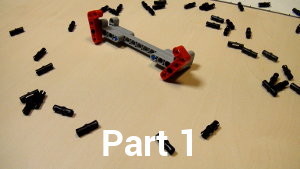
Quick Pinless Attachments for LEGO Mindstorms Competition Robots
Ways of using pinless attachments that could collect the brick.
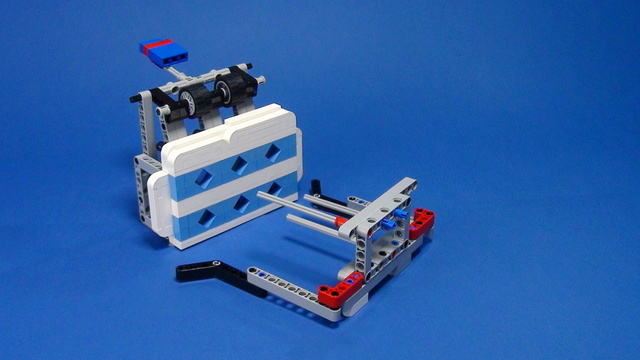
FIRST LEGO League Competition. Attachments
The whole complete course on the attachments.
Tip:
Here you just need an agent with large wheels. Note that it is not necessary the robot to be that agent. We've shown a number of constructions with larger wheels and a frame, but the frame could be removed.
Categories:
Look for inspiration:

SUV Competition Box Robot from LEGO Mindstorms EV3
Large clearance. Good high. Perfect balance. The box robot for this mission.

BigDaddy Front - front wheels mechanism module for a large LEGO Mindstorms Competition Robot
A sample for a construction with large wheels

Big Daddy Competition Construction
The whole big daddy construction gives a nice idea for a high chassis with a lot of clearing.

LEGO Box Robot Three With Large Wheels and Thee light sensors and one Gyro
This box robot is with large wheels. Probably, some of the lower side beams could be removed.

Box Robot Three With Large NXT Wheels
Another example for a box with large wheel. Some of the parts should be removed.

WRO Robot building instruction
A robot chassis with large wheel and a frame

Clank - LEGO EV3 Ammo Truck
This chassis is without any frames. Could be useful.
Tip:
This mission can be solved with a simple passive attachment. However, if you want to collect the core samples you will probably want to use some kind of container. In that case it will be easier for you if you use a simple active attachment. Once you have collected the samples, you can bring them to base and later deploy on the desired places.
Categories:
Look for inspiration: (still thinking :))
Tip:
Now this is interesting. It will require quite a lot. The mission is divided in two parts. On one hand, you have to take out modules from the space station and on the other, you have to attach new modules. However, both of them require precise positioning. This can be achieved by using self-aligning attachments.
Categories:
Look for inspiration:

Attachment that mechanically aligns to a mission model - Cloud Challenge from FLL World Class
A good example for self-aligning attachment
Tip:
We are in an argument here among ourselves. Should you lift the Gerhard astronaut directly up and then release him into the airlock chamber or.... should you take him with the robot, return to base and use another attachment to release him into the airlock. We have a couple of videos for taking the astronaut with the loop collect mechanism. Release is with a carabiner.
Categories:
Look for inspiration:

Improving FLL Robot Game. Using a rack for Lifting.
An example for a rack that lifts an object up and down

Rubber bands - Solving the FIRST LEGO League World Class COMMUNITY TREE
A tutorial for carefully lifting an object with a rubber band

Rubber bands pinless attachment for taking loops
More on attachments with rubber bands that could lift objects

Rubber Band Attachment for loops pushed to the border - FLL2012 Medicine
Even more on rubber band attachments
Tip:
Again two main approaches. You could have a simple active attachment that repeatedly pushes the handle(s). Another way would be to have a passive attachment and move the robot back and forth and push on the handles. This will reduce the number of attachments that you have to build with 1, but the solution will probably be slower because you have to move the whole robot. Or as a third option, kind of advanced is to have an attachment with rubber bands to continuously push them.
Categories:
Look for inspiration:

Rubber band attachment with a flywheel - solving FLL 2014 Search Engine (part 1)
By customizing the attachment the movement could be changed from just forward to back-and-forth linear movement

Box Robot Two.Left side attachment with self-locking
The locking mechanism could move to a certain position and then be locked. Now this is called "Reciprocating" (yes, we had to google this word). Great for pumping on the handler by the way.

Box Robot Two. Push/Pull attachment with a Rack on the right side
Classic push/pull

Reusable geared active attachment for changing LEGO gears orientation
Because you need a simple lever on the side of the robot you could transfer the power from the front to the side.
Tip:
The bar should be lifted about 8 LEGO units. When lifting is involved you can use Rack(s), Gears, Scissor Mechanism and the different variations of these mechanisms.
Categories:
Look for inspiration:

Attachments for Box Robot for Robotics Competitions. Lifting heavy elements with an Active Attachment
An example for a LEGO attachment for lifting.

Lifting with a rack
Or you could lift with a rack

Heavy lifting with a detachable LEGO Mindstorms attachment
Or you could lift with a scissor. This is the tutorial.

WRO Catch and Move Robot. Full Version
There is an interesting lifting mechanism on the top of this robot. Look at how it is constructed.

Heavy lifting detachable attachment for the Senior Solutions Competition
Building instructions for an example of a scissor mechanism.

Scissors mechanism for Lifting
A more detailed course on mechanisms for lifting.

Box Robot Two. Push/Pull attachment with a Rack on the right side
Again the rack and a classic on this subject.
Tip:
At first glance the mission is quite simple you just have to push the bar. The challenge is to push it at the right speed and to the right distance. A flywheel with a rubber band is an interesting way to do such missions and you could use the benefit if the attachment does not require a motor, but a rubber band.
Categories:
Look for inspiration:

Rubber band attachment with a flywheel - solving FLL 2014 Search Engine (part 1)
Control the speed and distance of the push

One attachment for Solving FIRST LEGO League 2014 World Class missions
There is a similar mission accomplished here with the robot.

Box Robot Two. Push/Pull attachment with a Rack on the right side
The rack could always be used for push/pull
Tip:
Hit it. And hit it hard. You can use some more complex attachments with rubber bands and motor, but the simplest way would be have a long level with a weight at the top. The weight could be a tire. This will use the inertia of the robot and will not even require a motor.
Categories:
Look for inspiration:

Throwing a ball with a rubber band attachment - FLL 2012 bowling
Whether rubber bands would be sufficiently strong is a matter of test for this mission, but here is an example for throwing a ball.

Quick Pinless EV3 Attachment
Use the inertia of the robot to press on the mission model. These are the building instructions.

Quick Pinless Attachments for LEGO EV3 Competition Robots (Part 2)
Move forward and the attachment just falls. Use the inertia.
Tip:
Move with an object. When moving with an object you could lift the object in the air, move and then release it. We've done this in a previous Natures Fury competition for an ambulance and a truck. Here it is not necessary to lift the object. You could just push/pull the satellites and you could do this with the robot itself and without any attachments
Categories:
Look for inspiration:

Box Robot Building Instructions. Part 2
You could use the box robot and just push with it.

EV3 Competition Robot Full
The competition robot is also a good example for a robot construction and you could push with it.

Rubber bands, Gear wheels and motors for accomplishing FLL 2013 Truck and Ambulance
If you want to overengineer it, that's the way. :). But don't do it. But if you accomplish it in a similar way send us a picture or a video.

WRO Catch and Move Robot. Light Version
Grabs and lifts and object. Again, an overengineering for this particular task, but it is funny and interesting.

WRO Junior-High 2014. Sputnik.
There was a similar competition at WRO at 2014.
Tip:
The easiest way, probably, would be to use the robot and push on the lever. How important are the 2 to 4 points that you could make if you manage to push it to the orange section. If they are important for you use the light and gyro sensors to align to the borders and the lines and precisely position the robot.
Categories:
Look for inspiration:
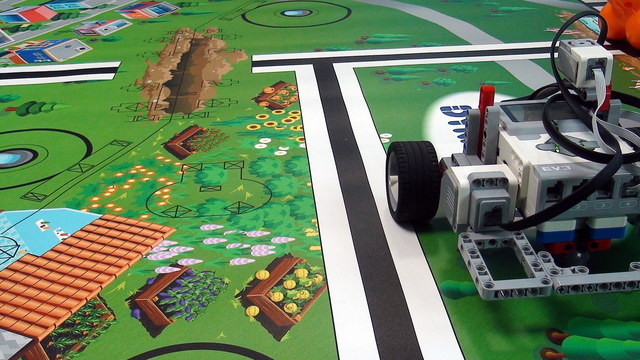
Moving Straight with LEGO Mindstorms EV3 robots
Everything you need to know about the gyro sensor.

WRO Elementary 2015. Field Run. Part 1
Example for robot that is aligning with the gyro sensor and is using the block for aligning.

WRO Elementary 2015. Field Run. Part 2
The second part of the example of aligning.
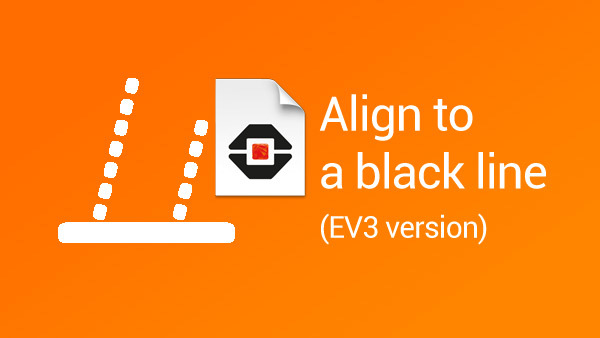
How to align LEGO Mindstorms robots to a black line (EV3 version)
A whole course section dedicated to using the color sensor for aligning and simple following
Tip:
You've got to 'throw' a ball. This could happen with a kick with a motor or with a rubber band. It really depends on the distance and the speed.
Categories:
Look for inspiration:

Solving the FIRST LEGO League World Class sports mission
Several examples of shooting a ball from a distance and with an obstacle between the robot and the target

One attachment for Solving FIRST LEGO League 2014 World Class missions - part 2
Review of another way to push a ball.

Throwing a ball with a rubber band attachment - FLL 2012 bowling
Shooting a ball with a rubber band.

Rubber band attachment for throwing a ball from base - FLL 2012 Bowling
A different tutorial for shooting a ball.

Torvi - Ball shooting Lego machine
The newest and greatest example for shooting a ball. Yes, it requires a lot of parts and motors, but it presents a nice idea.
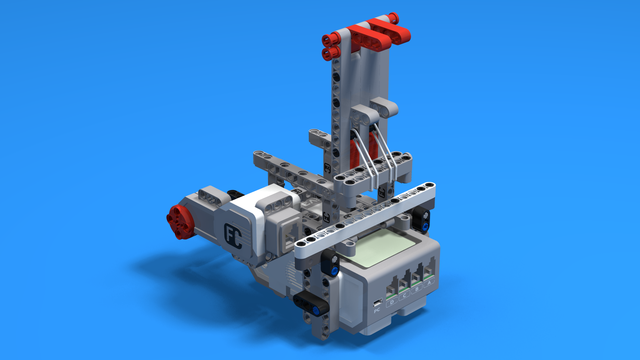
Catapult over the brick
Building instructions for a really small catapult

Catapult without a bottom base built from LEGO Mindstorms EV3
Building instruction for the complete large catapult
Tip:
Catch it. Then it would be easier to return it to base. On some of the next runs out of base you could place it in the target area along with other things you've collected.
Categories:
Look for inspiration:

Solving the FIRST LEGO League World Class Robotics Competition mission
An example for a mission where we collect object locate high in the air above the robot
Tip:
Know all the competition rules in order not to get caught off guard.
Categories:

















